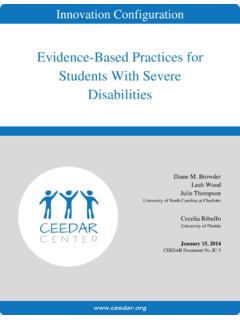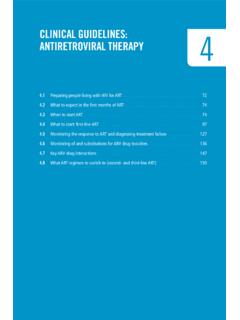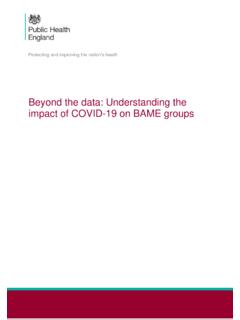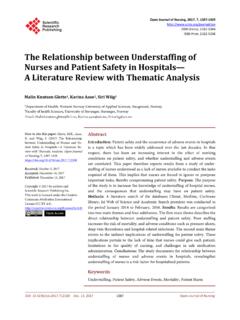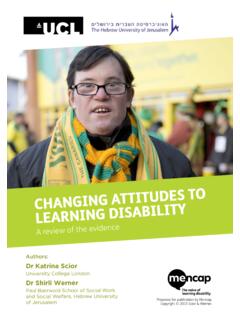Transcription of BRAIN TRAUMA FOUNDATION TBI GUIDELINES
1 GUIDELINES for the Management of SevereTraumatic BRAIN Injury, Fourth EditionThe scope and purpose of this work is 2-fold: to synthesize the available evidence andto translate it into recommendations. This document provides recommendations onlywhen there is evidence to support them. As such, they do not constitute a completeprotocol for clinical use. Our intention is that these recommendations be used byothers to develop treatment protocols, which necessarily need to incorporate con-sensus and clinical judgment in areas where current evidence is lacking or insuffi-cient. We think it is important to have evidence - based recommendations to clarifywhat aspects of practice currently can and cannot be supported by evidence , toencourage use of evidence - based treatments that exist, and to encourage creativityin treatment and research in areas where evidence does not exist.
2 The communities ofneurosurgery and neuro-intensive care have been early pioneers and supporters ofevidence- based medicine and plan to continue in this endeavor. The completeguideline document, which summarizes and evaluates the literature for each topic,and supplemental appendices (A-I) are available online at WORDS: severe traumatic BRAIN injury, Adults, Critical care, evidence - based medicine, GUIDELINES , Sys-tematic reviewNeurosurgery 0:1 10, 2016 DOI: the Fourth Edition of the BRAIN TraumaFoundation s GUIDELINES for the Managementof severe Traumatic BRAIN Injury, there are189 publications included as evidence to support28 recommendations covering 18 topics. Thepublication reports on 5 Class 1 studies, 46 Class2 studies, 136 Class 3 studies, and 2 synopsis provides anoverview of the process,includes the updated recommendations, and de-scribes the new evidence added.
3 The completeguideline document, which summarizes and eval-uates the literature for each topic, and supplemen-tal appendices (A-I) are available online at the past 20 years, the BRAIN traumacommunity s approach to guideline developmenthas evolved as the science and application ofevidence- based medicine has advanced. This newiteration of the GUIDELINES reflects the most currentmethodologic standardsandestablishesmorerigorous procedures for future work. As a result,the GUIDELINES include changes in the evaluation ofpreviouswork,anincreaseinthequalityoft heincluded studies, and essential improvements inthe precision of the recommendations. Details onthe changes within each topic from the Third1tothis Fourth Edition are listed in Appendix A in thecomplete Fourth Edition GUIDELINES and aredescribed in the sections on each topic in thecomprehensive guideline document.
4 These areavailable online at these improvements, the recommenda-tions are limited in many areas, reflecting persistinggapsintheevidencebaseforsevere traumaticbraininjury (TBI) management. Although there havebeen numerous new publications in the field sincethe Third Edition of the GUIDELINES was publishedin 2007,1many repeat the same methodologicflaws found in previous research. The comprehen-sive guideline document includes an examinationof the current condition of BRAIN TRAUMA clinicalresearch, outlines how this condition is definingand shaping the future, and proposes a solution inestablishing a formal evidence - based Carney, PhD*Annette M. Totten, PhD*Cindy O Reilly, BS*Jamie S. Ullman, MD Gregory Hawryluk, MD,PhD Michael J. Bell, MD Susan L. Bratton, MD Randall Chesnut, MDkOdette A.
5 Harris, MD, MPH#Niranjan Kissoon, MD**Andres M. Rubiano, MD Lori Shutter, MD Robert C. Tasker, MBBS, MD Monica S. Vavilala, MDkJack Wilberger, MDkkDavid W. Wright, MD##Jamshid Ghajar, MD, PhD#*Oregon Health & Science University,Portland, Oregon; Hofstra North Shore-LIJ School of Medicine, Hempstead, NewYork; University of Utah, Salt Lake City,Utah; University of Pittsburgh, Pitts-burgh, Pennsylvania;kUniversity ofWashington, Seattle, Washington; #Stan-ford University, Stanford, California;**University of British Columbia, Vancou-ver, British Columbia, Canada; ElBosque University, Bogota, Colombia; MEDITECH FOUNDATION , Neiva, Colom-bia; Harvard Medical School & BostonChildren s Hospital, Boston, Massachu-setts;kkDrexel University, Pittsburgh,Pennsylvania.
6 ##Emory University, Atlan-ta, GeorgiaReviewed for evidence - based integrityand endorsed by the AmericanAssociation of Neurological Surgeonsand the Congress of :Jamshid Ghajar, MD, PhD,Department of Neurosurgery,Stanford University School of Medicine,300 Pasteur Drive, R200,Stanford, CA : 8, ,August 14, 2016 BRAIN TRAUMA : TBI,traumatic BRAIN injury;RES-CUEicp,Randomised Evaluation of Surgery withCraniectomy for Uncontrollable Elevation of ICPBRAIN TRAUMA FOUNDATION TBI GUIDELINESBRAIN TRAUMA FOUNDATION TBI GUIDELINESNEUROSURGERYVOLUME 0 | NUMBER 0 | MONTH 2016 |1 Copyright 2016 BRAIN TRAUMA FOUNDATION . Unauthorized reproduction of this article is of the GuidelinesThe GUIDELINES address treatment interventions, monitoring,and treatment thresholds that are specific to TBI or that addressa risk that is greater in patientswith TBI.
7 The GUIDELINES are notintended to cover all topics relevant to the care of patients withsevere TBI. Topics related to general good care for all patients, orall TRAUMA patients, are not protocols that integrate TBI-specific, evidence -basedrecommendations with general best practices for TRAUMA patients,and that provide guidance, suggestions, or options in areas of TBImanagement where the evidence is insufficient, is outside the recommendationsare intendedtoprovidethe FOUNDATION on which protocols can be developed that areappropriate to different treatment GuidelinesThis Fourth Edition of the GUIDELINES is transitional. We donot intend to produce a Fifth Edition. Rather, we are moving toa model of continuous monitoring of the literature, rapidupdates to the evidence review , and revisions to the recommen-dations as the evidence warrants.
8 We call this the LivingGuidelines model. This is driven by several trends, includingadvances in technology, the increasing volume of availableinformation, and the corresponding change in expectationsamong clinicians and other stakeholders. A static document thatis updated after several years no longer responds to the demandsof the community we first test of this approach will involve incorporating theresults of the RESCUEicp (Randomised Evaluation of Surgerywith Craniectomy for Uncontrollable Elevation of ICP) study,which was published just after the completion of this edition. Thisstudy is a randomized, controlled trial that evaluates decompres-sive craniectomy as a secondary procedure, after ICP-targetedmedical therapies have results of this trial will beevaluated and may impact recommendations related to decom-pressive craniectomy as well as ICP development of GUIDELINES encompasses 2 major activities: first,a systematic review and synthesis of evidence .
9 And second, the derivationof evidence review and SynthesisLiterature Search and ReviewOur literature search protocol is detailed in the comprehensive guidelinedocument, and the search strategies are in Appendix D to the same documents are available online at key criteria for including studies in the review were as follows: thepopulation was adult patients with severe TBI (defined as Glasgow ComaScale Score of 3-8), and the study assessed an included outcome(mortality; neurologic function; or appropriate, selected, intermediateoutcomes for the topic). Differences were resolved via consensus or bya third reviewer. Detailed inclusion criteria and a list of studies excludedafter full-text review are in the comprehensive guideline document inAppendices E and Assessment and Data Abstraction of IndividualStudiesAll included studies were assessed for potential bias, which isa systematic approach to assessing the internal validity or quality ofstudies.
10 The criteria used in the Third Edition were maintained andapplied to the newly identified studies of monitoring and criteria for threshold studies were revised to be specific to thestructure of threshold studies (see Appendix G for a complete list ofthe quality criteria used for individual studies). Key data elementsthen were extracted from each study. These were provided to theguideline panel and summarized by topic in the guideline document(see summary by topic in the comprehensive guideline documentavailable online at ).Class 1 is the highest class and is limited to good-quality randomizedtrials. Class 2 includes moderate-quality randomized controlledtrials and good-quality cohort or case-control studies. Class 3 is thelowest class and is given to low-quality randomized controlled trials,moderate- to low-quality cohort or case control studies, and caseseries and other non-comparative final phase of the evidence review is the synthesis of individualstudies into information that the Clinical Investigators and the MethodsTeam use to develop recommendations.
